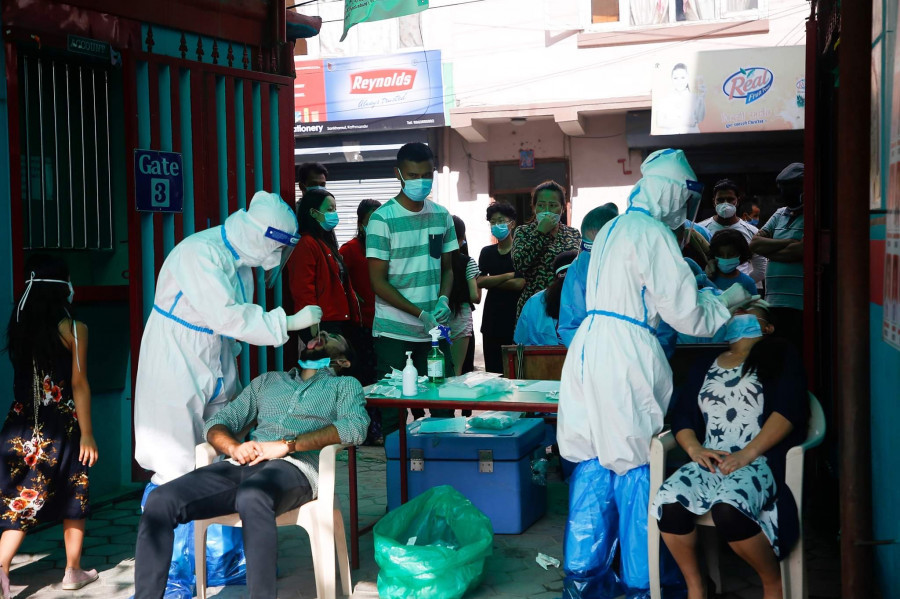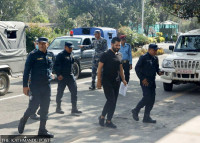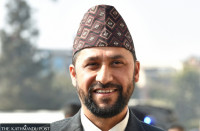National
Despite growing evidence, Health Ministry says no community transmission yet
With the system overwhelmed, infected not being tested later to prove they are virus-free and told to continue in home isolation and cases rising, Covid-19 threat is increasing, experts say.
Arjun Poudel
Over the last two weeks, the number of people from Kathmandu Valley seeking Covid-19 tests at Sukraraj Tropical and Infectious Disease Hospital has suddenly risen, and consequently, according to doctors, the Valley is reporting more and more coronavirus cases.
“Until two weeks ago, the majority of people seeking tests were from outside the Valley,” said a doctor at Sukraraj hospital who spoke on condition of anonymity. “But the recent data show locals from core areas like Kalimati, Balkhu, Koteshwor, Ason, Bhothahiti and Thamel among others have tested positive.”
These areas are densely populated and the situation is getting quite alarming, according to the doctor.
Of the total 927 cases reported across the country on Friday, 415, or 45 percent, were from the Valley and 80 percent of them were the Valley locals, according to the Epidemiology and Disease Control Division. Doctors said 40 percent of them were asymptomatic, painting even a graver picture. Even 15 people of a single extended family have tested positive, according to them.
Even though public health experts have said the virus has taken hold in the society, the government has yet to confirm community transfer.
“We don’t have evidence to declare community transfer yet even though there are some arguments by some claiming so. But we need solid evidence,” said Dr Sameer Kumar Adhikari, joint-spokesperson for the Health Ministry. “But we cannot also rule out that there is no community transfer. That could be a possibility, but the ministry has yet to make a formal announcement to that regard.”
Dr Sher Bahadur Pun, chief of the Clinical Research Unit at Sukraraj hospital, however, said he is wondering what evidence the authorities are looking for to be convinced that there is community spread of the virus.
“The virus has already encircled us from all sides. People from communities, those without any travel history to virus hotspots or who have never come in contact with the infected people are testing positive” Pun told the Post. “This is a clear indication that the virus has penetrated the society.”
In its situation report on Nepal, updated on August 21, the World Health Organisation said six of the seven provinces, including Bagmati where Kathmandu Valley falls, are having transmission in clusters. The UN health agency stressed that a sensitive surveillance system with fully functional and strengthened contact tracing and follow-up system “would be critical now to detect the signs of community transmission and to control it quickly.”
The WHO situation report came two days after prohibitory orders were imposed in the Valley, with the authorities restricting public and vehicular mobility and barring shops and businesses from operating. The prohibitory orders, issued effective August 18 midnight for a week, have been extended until September 2 midnight.
The authorities, however, are scrambling to ensure effective contact tracing, with more infections reported–and from various areas.
As of Saturday, 37,340 people have tested positive for Covid-19, including 207 deaths. According to the Health Ministry, 884 people tested positive in the last 24 hours, including 186 new infections in Kathmandu Valley.
The government has stopped short of making public what measures it is taking to break the transmission chain.
The World Health Organisation says community transmission is evidenced by the inability to relate confirmed cases through chains of transmission for a large number of cases, or by increasing positive tests through sentinel samples.
Tests through sentinel samples require routine systematic testing of samples from established laboratories.
The Health Ministry instead has directed hospitals not to perform polymerase chain reaction tests twice on a single person, discharge patients in 14 days and encourage patients to practice home isolation.
“We have no alternative than to encourage home isolation,” Dr Bikash Devkota, chief Quality Control and Regulation Division of the Health Ministry, told the Post. “Given our capacity, we can accommodate only symptomatic patients at present. In the coming days, if cases keep rising, we might have to accommodate only serious cases in hospitals. We may need to ensure smooth supply of oxygen for people who are kept in isolations.”
Devkota said that the virus could have reached community level but refused to confirm, saying it’s the Health Ministry that should make such a declaration.
Public health experts have long argued that restrictions without stepping up measures like ensuring isolation beds, ventilators and dedicated Covid-19 hospitals and placing people in home quarantine or isolation could spell a disaster.
Doctors say while the government has failed in its fight against the virus, it has also not been able to communicate with the people properly to make them aware of the threat.
On Friday, there were concerns after reports that three ministers were in home isolation after they were exposed to a person with Covid-19. All three, however, tested negative for Covid-19 on Saturday, according to Madhav Prasad Tiwari, press advisor to Health Minister Bhanubhakta Dhakal.
Dhakal, along with Defence Minister Ishwar Pokhrel and Home Minister Ram Bahadur Thapa, had attended a meeting of the Covid-19 Crisis Management Centre at its Secretariat situated on the premises of the Nepal Army’ Chhauni barracks on Sunday.
Dr Baburam Marasini, former director at the Epidemiology and Disease Control Division, said there is negligence all around–those in powerful positions continue to make light of the possible threat and members of the public seem to be not following the safety protocols.
If the situation arose forcing three ministers to go into self-isolation, then it just shows they are not taking proper precautions, according to Marasini.
“Last month I was invited to an experts’ meeting at the Health Ministry, but the meeting hall was so crowded,” added Maraasini. “I was extremely worried about infection. I have decided not to participate in such meetings again.”
Doctors say a vaccine against the virus is not coming anytime soon and that the public should make sure that they remain safe, as the government has by and large failed to take concrete measures to contain the virus spread.
“Our infrastructure is already getting overwhelmed. If cases continue to rise at this rate, it will be difficult for the Covid-19 patients to get intensive care unit beds and ventilators,” said Pun, who is also a virologist. “People may start dying without getting to visit the hospital.”




 16.12°C Kathmandu
16.12°C Kathmandu















